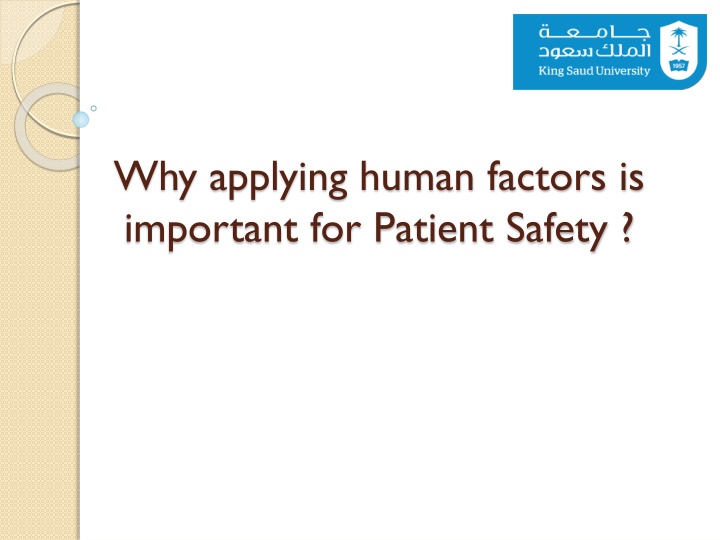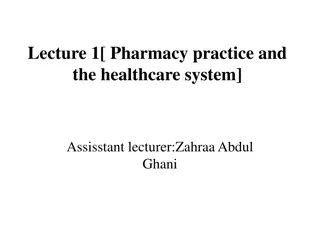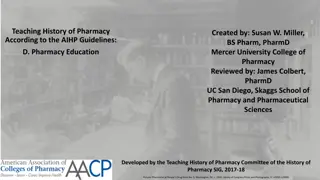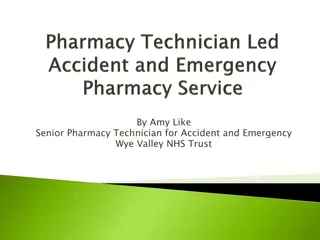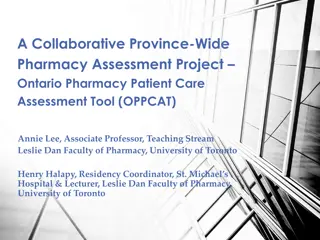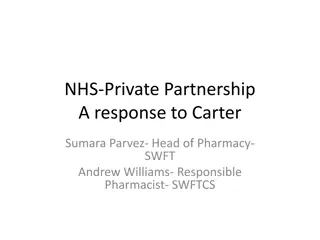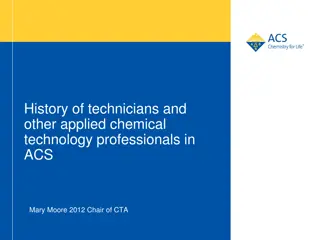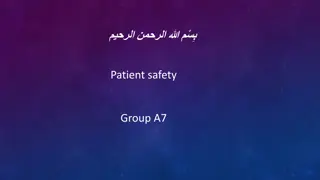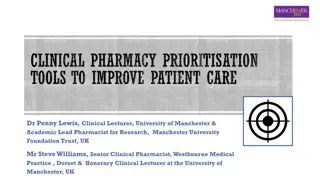Importance of Human Factors in Patient Safety: A Pharmacy Technician's Deadly Mistake
Applying human factors is crucial for patient safety, as demonstrated by the tragic case of Emily Jerry, a two-year-old girl who lost her life due to a pharmacy technician's deadly mistake in preparing a chemotherapy solution. The oversight and miscommunication between healthcare professionals led to a fatal error, highlighting the critical role of human factors in healthcare. This incident underscores the importance of effective communication, proper training, and attention to detail in preventing such tragedies.
Download Presentation

Please find below an Image/Link to download the presentation.
The content on the website is provided AS IS for your information and personal use only. It may not be sold, licensed, or shared on other websites without obtaining consent from the author.If you encounter any issues during the download, it is possible that the publisher has removed the file from their server.
You are allowed to download the files provided on this website for personal or commercial use, subject to the condition that they are used lawfully. All files are the property of their respective owners.
The content on the website is provided AS IS for your information and personal use only. It may not be sold, licensed, or shared on other websites without obtaining consent from the author.
E N D
Presentation Transcript
Why applying human factors is important for Patient Safety ?
A Pharmacy Technician's Deadly Mistake
Todays video is going to be about a very important subject, the reason why she made that video is to drive a home the fact that a pharmacy technician s job is important, because a lot of people think that its not. We will talk about two things: (which are mentioned in the video): 1-A story about a little girl her name is Emily Jerry. 2-The purpose of pharmacy technicians video guide (this video) https://youtu.be/XtiEkfZX82w
Emily's Condition Emily jerry, a two-year-old girl was diagnosed with an abdominal tumor She received her treatment at rainbow babies and children's hospital in Cleveland, Ohio The treatment included chemotherapy On February 28th, 2006, Emily received the last of her chemotherapy treatment MRI showed great improvement of Emily's condition as the tumor was no longer exist and then she was set to go home
Katherine Dudash's Recklessness On February 28th, 2006, a pharmacy technician named Katie dudash s prepared a chemotherapy solution for Emily with it containing a 23% salt The formula called for a saline base (salt) of less than 1% meaning that Katie dudash s just did a grave mistake As the reports stated that dudash s had already her hands full with preparations of her wedding
The Tragedy Eric cropp, the pharmacist who was in charge during this crisis was informed by Katie that something seemed "off" After mixing the chemotherapy dose Unfortunately cropp ignored dudash's warning and the lethal dose was administrated to Emily Shortly afterwards, Emily woke up screaming and saying "mommy, my head hurts" On the 1st of march, 2006, 3 days after receiving the lethal dose, The innocent child Emily jerry died
Katherine Dudashs Fate As a pharmacy technician Katie s mistakes fell on Erics shoulders, even though she is the one that actually mixed the dose. She was fired from Rainbow babies and children hospital Then she went to work in another hospital, also as a pharmacy technician, after knowing of her previous mistake the hospital placed her on leave while they investigated Katie escaped any and all prosecution and legal responsibility for Emily Jerry s death
Emilys Parents Sued Rainbow babies and children hospital Won a $7 million settlement And they founded the Emily Jerry Foundation The legacy of the foundation is Emily s law; which states that : )all pharmacy technicians in the state of Ohio must adhere to strict requirements and regulations)
Conclusion Most pharmacy technicians are not going to be involved in mixing chemotherapy, that particular job is a responsibility of an institutional pharmacy technician. institutional pharmacy technician: is a hospital pharmacy technician, so they are the technicians who work in a hospital or an institutional setting as opposed to a retail setting. Because institutional pharmacy technician positions usually get paid more and obviously have greater responsibilities, most hospitals are not going to hire you without you having some sort of educational degree or at least employment experience. The national pharmacy technician association offer voluntary chemotherapy certification training courses The Emily Jerry foundations aims to raise the public awareness about pharmacy errors and try to obtain tighter regulations for pharmacy technicians.
A high reliability organization (HRO) is an organization that has succeeded in avoiding catastrophes in an environment where normal accidents can be expected due to risk factors and complexity There are five characteristics of HROs that have been identified as responsible for the "mindfulness" that keeps them working well when facing unexpected situations. Preoccupation with failure Reluctance to simplify interpretations Sensitivity to operations Commitment to resilience Deference to expertise
HRO model: Commitment to resiliency. As the old Proverb says: "if you don't bend, you break". Resiliency is the ability to handle accidents or mistakes while still being able to function and solve them as they happen quickly. It's about being ready for any problem whenever it occurs, solve it, and be able to learn from it and apply that knowledge to prevent such incidents in the future. Resiliency means that whenever a grave accident happens, the team returns to function as soon as possible in the aftermath of the accident. To be Resilient is to be Reliable.
Done by: Abdulaziz Shadid yazeedAlsuhaibani Abdullah Alhamdi Abdullah Alhaddab Majed Alzin NawafAlfaifi Waleed Mijlad NawafAlamri Basel Almeflh Husam alkhathlan
